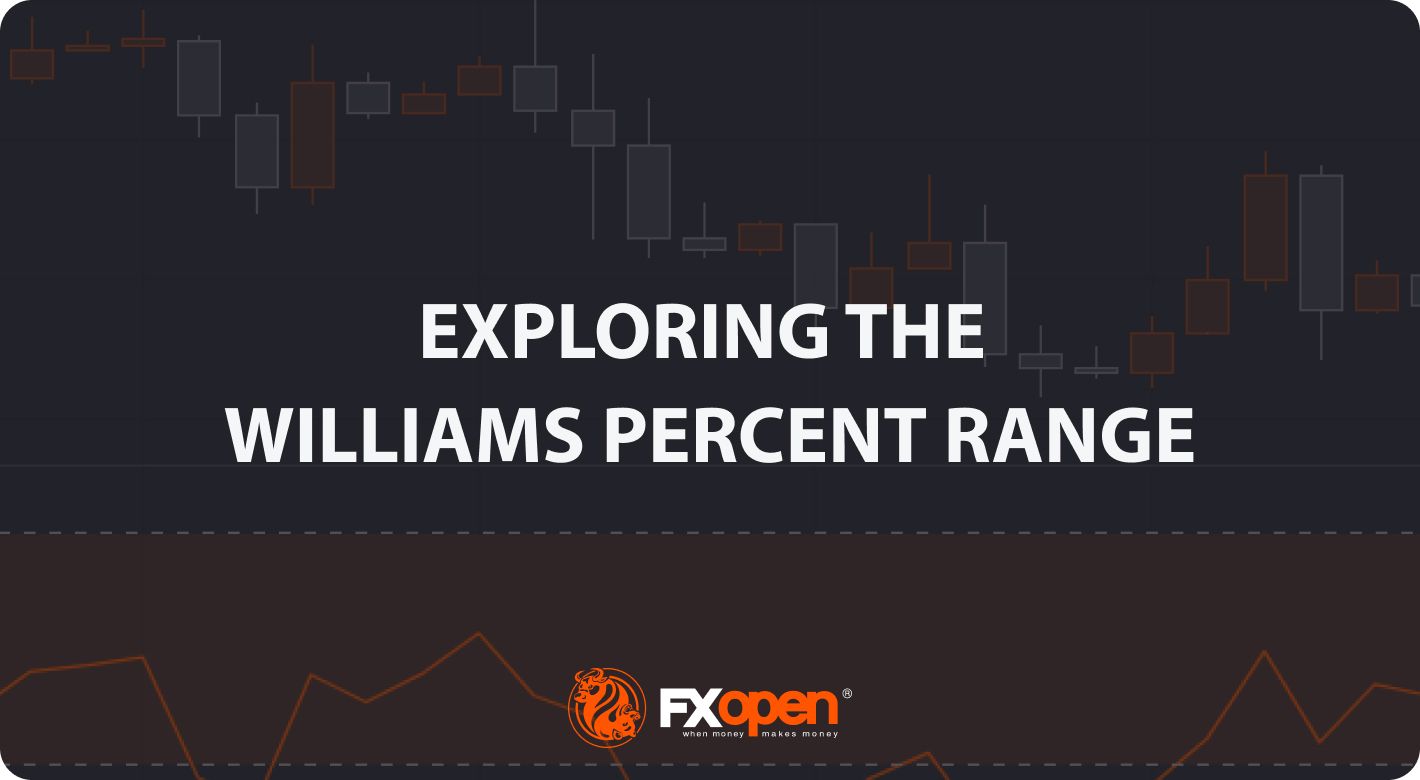FXOpen

In the vast realm of technical analysis, traders employ various indicators to assist them in making informed trading decisions. One such popular indicator is the Williams Percent Range (Williams %R). It’s one of the simplest indicators, and it only has one use case. Still, it’s known by traders worldwide. In this FXOpen article, we will tell what is so special about the Williams %R.
What Is the Williams Indicator?
Developed by the renowned trader and author Larry Williams, the Williams %R is a momentum oscillator that helps traders identify overbought or oversold conditions in the market. You may be aware of the relative strength index and the stochastic oscillator, which are also used to determine periods when an asset is overbought or oversold. Moreover, the Williams %R indicator is always compared to the stochastic. We will highlight the differences in the following paragraphs.
How to Calculate the Williams Percent Range Indicator
The indicator measures the relationship between the current closing price and the high-low range over a specified period.
The calculation of the Williams %R involves several steps and can be performed using the following formula:
Here, the "Highest High" represents the highest price observed over a specified period, the "Close" denotes the most recent closing price, and the "Lowest Low" signifies the lowest price observed during the same period.
Typically, the Williams %R is calculated over a period of 14, but traders can adjust it according to their preferences and trading strategies. Shorter periods result in more sensitive and volatile readings, while longer periods provide a smoother and less volatile indicator with fewer signals.
How to Use the Williams %R in Trading
Overbought/Oversold Market Conditions
The Williams %R offers traders valuable insights into potential reversals and trend changes in the market. It is displayed as a line that oscillates between 0 and -100, with readings above -20 indicating overbought conditions and readings below -80 suggesting oversold conditions.
When the indicator reaches overbought levels, it suggests that the market may be due for a downward correction or a trend reversal. Conversely, when the indicator reaches oversold levels, it implies that the market may be primed for an upward correction or a trend reversal.
In the chart above, the indicator crossed the overbought area, and once it moved below -20, the uptrend reversed (1). However, later the indicator visited the overbought zone several times, but the actual trend reversal occurred much later (2).
This shows that the William Percent Range can’t be used on its own and that it should be confirmed with signals from other technical analysis tools.
Divergences
Another way to use the indicator is to look for divergences with the price action. For example, if the price of an asset is making lower lows while the Williams %R is making higher lows, it could indicate a potential bullish reversal. Conversely, if the price is making higher highs while the Williams %R is making lower highs, it could suggest a bearish reversal (1).
Price Momentum
The theory states that traders can use the Williams %R to identify price momentum. When the indicator moves out of the overbought or oversold zone and crosses back inside, it may signify a change in the market sentiment and present an opportunity to enter or exit a trade. However, as you can see in the example above, the William Percent Range can visit an overbought/oversold area many times before the trend reverses.
Williams %R and the Fast Stochastic Oscillator: Do They Differ?
While the Williams %R and the fast stochastic oscillator both belong to the family of momentum oscillators, there are notable differences between the two indicators. The primary distinction lies in the scaling and interpretation of the readings.
Scaling
The Williams %R is a reversed version of the fast stochastic oscillator, where the values range from 0 to -100 instead of 0 to 100. This reversal makes it easier for traders to identify overbought and oversold conditions. Moreover, the overbought and oversold levels for the Williams %R are set at -20 and -80, respectively, while the fast stochastic oscillator uses 20 and 80 as the threshold levels.
Calculation
Another difference is the calculation methodology. The Williams %R compares the closing price to the high-low range, whereas the fast stochastic oscillator compares the closing price to the range between the highest high and the lowest low over a specified period.
Sensitivity
The Williams %R is known for its sensitivity and responsiveness to short-term price movements. It tends to generate more frequent and volatile signals than the fast stochastic oscillator. Traders who prefer a more aggressive and active trading approach may find the Williams %R more suitable for their needs.
On the other hand, the fast stochastic oscillator provides a smoother representation of price momentum. It is calculated using a moving average of the %K line and a smoothing factor for the %D line. This smoothing process helps filter out short-term fluctuations and may be preferred by traders who seek a more stable and reliable indicator.
Ultimately, the choice between the Williams %R and the fast stochastic oscillator depends on a trader's personal trading style, risk tolerance, and preference for sensitivity or smoothness in their trading signals.
To decide which oscillator suits your trading style best, you can use the TickTrader platform for free.
Number of Signals
Some traders prefer the Stochastic over the Williams %R because the former provides more signals. While the Williams Percent Range is mostly used to identify overbought and oversold market conditions, the Stochastic is widely used to determine divergences and place entry and exit points based on the %K and %D crosses.
Limitations of Using the Williams %R
While the Williams %R can be a valuable tool in a trader's arsenal, it is essential to acknowledge its limitations and exercise caution when using it as a standalone indicator.
- It is more effective in trending markets. Although there is no particular rule of when to use the indicator, experience shows that it may provide less reliable signals in ranging markets. During these periods, the indicator can frequently oscillate between overbought and oversold levels, resulting in false signals.
- It may produce incorrect signals even in trending markets. There is no perfect indicator, and the Williams %R isn’t an exception. It may provide false signals even in trending markets. This happens in strong trends when the price continuously sets new highs/lows, and the oscillator simply follows it. Therefore, traders never solely rely on its signals.
- It provides short-term signals. Regardless of the period used for indicator calculation, the Williams %R is designed to capture short-term price momentum and may generate signals that are not in alignment with the overall market trend.
Final Thoughts
The Williams %R is a popular momentum oscillator that helps traders identify overbought and oversold conditions in the market. It can be a valuable tool when used in conjunction with other technical indicators and analysis techniques. However, it is important to understand its limitations and exercise caution when relying solely on the Williams %R for trading decisions. By combining it with other tools and considering the broader market context, traders can enhance their trading strategies and make more informed decisions.
When you feel confident in your Williams %R strategy, you can open an FXOpen account to use your skills in live market trading.
This article represents the opinion of the Companies operating under the FXOpen brand only. It is not to be construed as an offer, solicitation, or recommendation with respect to products and services provided by the Companies operating under the FXOpen brand, nor is it to be considered financial advice.
Stay ahead of the market!
Subscribe now to our mailing list and receive the latest market news and insights delivered directly to your inbox.








